Living rooms are a central space in any home, and it’s important to make sure they are both functional and inviting for everyone in the family. When it comes to living room ideas for kids, there are a lot of factors to consider. From choosing the right furniture to incorporating art and inspiration, there are many ways to create a space that is both fun and functional for children of all ages.
Understanding the needs of children is key when designing a living room that is suitable for them. This may involve choosing furniture that is durable and easy to clean, as well as incorporating storage solutions that help keep the space organized. Additionally, creating a focal point in the room can help draw children’s attention and make the space more engaging. By balancing decor and functionality, it’s possible to create a living room that is both stylish and practical for the whole family to enjoy.
Key Takeaways
- Understanding the needs of children is key when designing a living room that is suitable for them.
- Balancing decor and functionality is essential for creating a kid-friendly living room.
- Incorporating storage solutions and creating a focal point can help make the space more engaging for children.
Understanding the Need for Kids’ Living Room
A living room is a space where families spend a lot of time together, making it essential to create a comfortable and functional space for everyone, including kids. A kids’ living room should be designed with their unique needs in mind, making it a safe and enjoyable space for them to play and relax in.
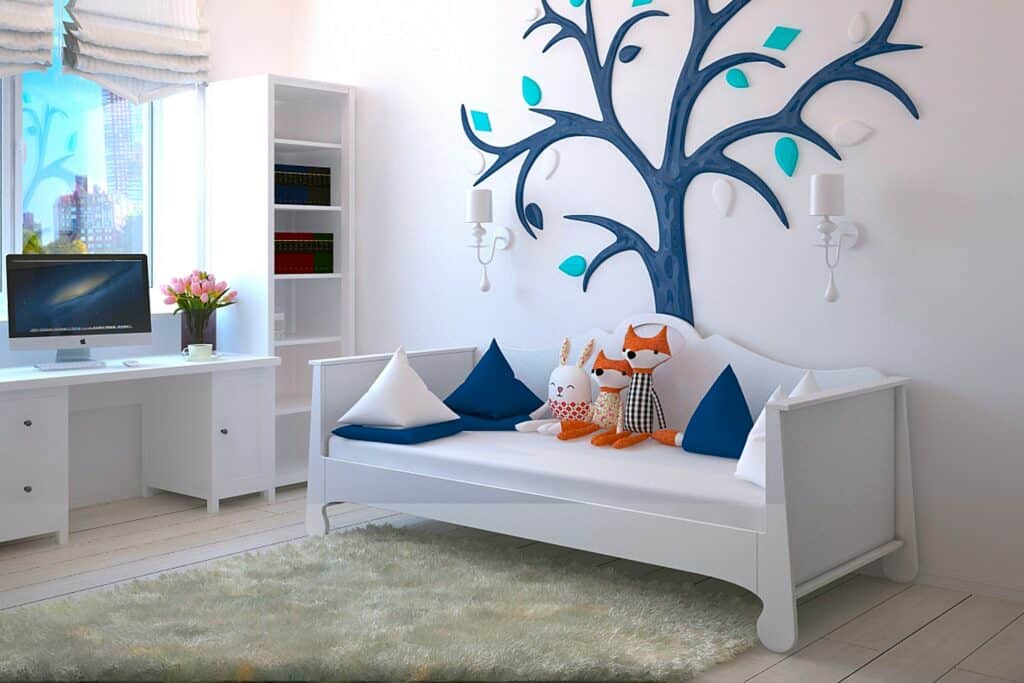
When designing a kids’ living room, it is important to consider the following factors:
Functionality
A kids’ living room should be functional, with plenty of storage space for toys and games. It should also be easy to clean and maintain, with durable furniture and materials that can withstand wear and tear.
Family-friendly
A family-friendly living room should be designed to accommodate everyone in the family, from young children to adults. This means choosing furniture and decor that is both stylish and practical, with plenty of seating options and a layout that encourages socializing and spending time together.
Kid-friendly
A kid-friendly living room should be designed with safety in mind, with soft edges and non-toxic materials. It should also be designed to encourage creativity and play, with plenty of space for kids to spread out and explore.
Overall, a kids’ living room should be a space that is both functional and fun, designed to meet the unique needs of children while also accommodating the rest of the family. By considering these factors when designing a kids’ living room, parents can create a space that is both safe and enjoyable for everyone.
Choosing the Right Furniture
When it comes to designing a living room for kids, choosing the right furniture is crucial. Not only does it need to be functional and practical, but it also needs to be kid-friendly and stylish. Here are some tips for selecting the right furniture for your child’s living room:
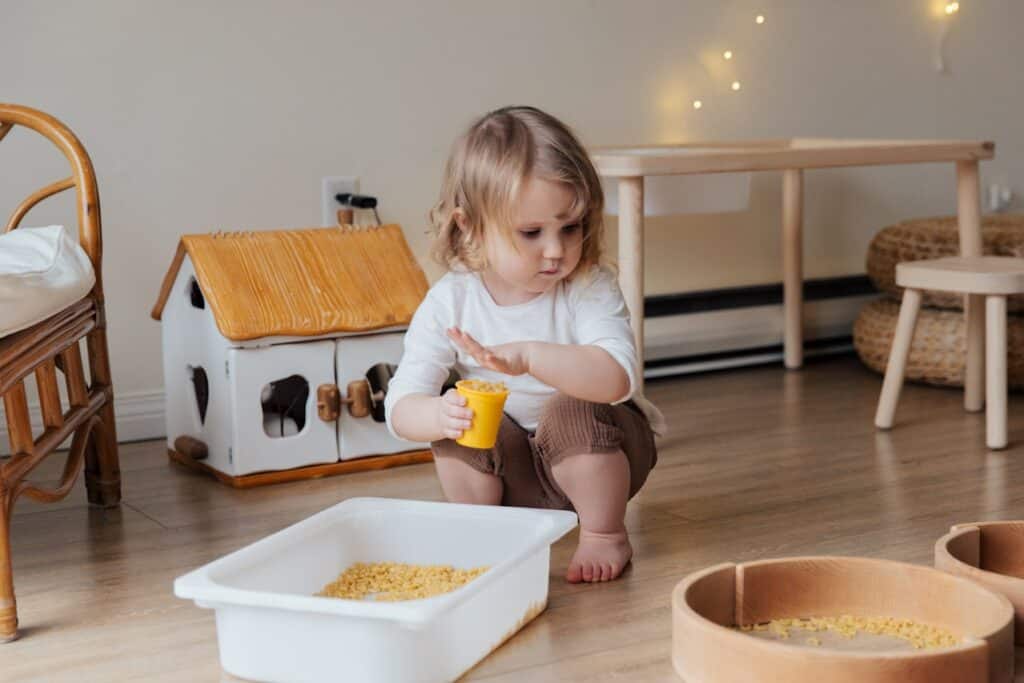
1. Functional Furniture
First and foremost, the furniture in your child’s living room needs to be functional. It should be able to withstand wear and tear, spills, and roughhousing. Consider investing in furniture made from durable materials, such as leather or microfiber, that are easy to clean and maintain.
Another important factor to consider is storage. Kids tend to accumulate a lot of toys and books, so having adequate storage solutions is essential. Look for furniture pieces that offer built-in storage, such as ottomans, coffee tables, and bookshelves.
2. Kid-Friendly Styles
In addition to being functional, the furniture in your child’s living room should also be kid-friendly. This means choosing pieces that are safe and comfortable for children to use.
When selecting furniture, consider the size and scale of the pieces. Kids tend to be smaller than adults, so choosing furniture that is appropriately sized for their height and weight is important. Look for chairs and sofas with supportive cushions and sturdy frames that can withstand the weight of active children.
Finally, consider the style of the furniture. While you want the living room to be kid-friendly, you also want it to be stylish and cohesive with the rest of your home decor. Choose furniture pieces that complement your existing style and color scheme, and don’t be afraid to mix and match different textures and patterns.
By following these tips for choosing the right furniture, you can create a functional and stylish living room that is perfect for kids.
Storage Solutions
When it comes to designing a living room for kids, storage is an essential component. In this section, we will explore some storage solutions that can help keep your living room organized and clutter-free.
Hidden Storage
One of the best ways to keep a living room tidy is by using hidden storage options. These storage solutions can be incorporated into furniture pieces, such as sofas, ottomans, and coffee tables. Here are some hidden storage ideas to consider:
- Storage Ottomans: Ottomans are a great way to add extra seating to a living room, and they can also be used for storage. Some ottomans have a removable top that reveals a storage compartment inside, while others have a hinged top that opens to reveal a storage area.
- Sofas with Storage: Some sofas have built-in storage compartments underneath the seat cushions. These compartments can be used to store extra blankets, pillows, or toys.
- Coffee Tables with Storage: Coffee tables with built-in storage compartments can be used to store magazines, books, or board games.
Clever Storage Options
In addition to hidden storage options, there are also clever storage solutions that can be used to keep a living room organized. Here are some ideas to consider:
- Shelving Units: Shelving units can be used to store books, toys, and other items. They can also be used to display decorative items, such as picture frames or vases.
- Baskets and Bins: Baskets and bins can be used to store toys, blankets, and other items. They can be placed on shelves or under tables to keep items out of sight.
- Wall-Mounted Storage: Wall-mounted storage options, such as hooks or shelves, can be used to store backpacks, jackets, and other items. This can help keep the living room clutter-free, while also making it easier for kids to find their belongings.
In conclusion, there are many storage solutions that can be used to keep a living room organized and clutter-free. By incorporating hidden storage options and clever storage solutions, you can create a functional and stylish living room that is perfect for kids.
Balancing Decor and Functionality
When designing a living room for kids, it can be challenging to strike a balance between decor and functionality. Parents want a space that looks great and reflects their personal style, while also being practical and accommodating for their children. Here are some tips to help achieve this balance:

1. Choose Kid-Friendly Fabrics
When selecting furniture and decor for a kid-friendly living room, it’s important to choose fabrics that are durable and easy to clean. Leather and microfiber are excellent choices, as they are both stain-resistant and easy to wipe down. Avoid light-colored fabrics that are prone to staining, and opt for darker colors or patterns instead.
2. Incorporate Storage Solutions
Kids come with a lot of stuff, so incorporating ample storage solutions is essential. Consider using ottomans or benches with hidden storage, or invest in a large storage unit to keep toys and other items organized. This will not only keep the living room looking neat and tidy, but it will also make it easier for kids to find and access their belongings.
3. Keep Decor Simple
While it’s tempting to go all out with decor, it’s important to keep things simple in a kid-friendly living room. Too many decorations can be overwhelming and distracting for children, and can make the space feel cluttered. Instead, opt for a few key pieces that tie the room together, such as a colorful area rug or a statement piece of artwork.
4. Incorporate Fun and Playful Elements
Just because a living room is kid-friendly doesn’t mean it has to be boring. Incorporating fun and playful elements, such as a chalkboard wall or a teepee, can add character and whimsy to the space. This will not only make the living room more enjoyable for kids, but it will also make it a space that the whole family can enjoy together.
Overall, when designing a living room for kids, it’s important to prioritize both decor and functionality. By choosing kid-friendly fabrics, incorporating storage solutions, keeping decor simple, and incorporating fun and playful elements, parents can create a space that is both stylish and practical for their children.
Incorporating Art and Inspiration
When designing a living room for kids, incorporating art and inspiration can be a great way to create a space that is both fun and educational. Here are some ideas to get started:
Wall Hangings
Adding wall hangings to a living room can be a great way to add color and personality to the space. When choosing wall hangings for a kid’s living room, consider incorporating inspirational quotes or images that promote creativity and imagination. Here are some ideas:
- Hang a world map to inspire a love of travel and exploration.
- Use a chalkboard wall to encourage drawing and creativity.
- Display a gallery wall of your child’s artwork to showcase their talents and boost their confidence.
Artwork for Kids
Artwork can be a great way to add color and personality to a living room while also inspiring creativity and imagination. When choosing artwork for a kid’s living room, consider pieces that are both fun and educational. Here are some ideas:
- Choose artwork that features animals or nature scenes to inspire a love of the outdoors.
- Hang posters of famous artists or art movements to introduce kids to different styles of art.
- Choose pieces that feature bright colors and bold patterns to add a playful touch to the space.
Overall, incorporating art and inspiration into a kid’s living room can be a great way to create a space that is both fun and educational. By choosing wall hangings and artwork that promote creativity and imagination, you can create a space that your child will love spending time in.
Color Schemes and Bedding Choices
Choosing a Color Scheme
When it comes to choosing a color scheme for a kid’s living room, it’s important to keep in mind that children have different preferences and needs than adults. Bright, bold colors are often a hit with kids, but it’s important to balance them with more neutral tones to avoid overwhelming the space. Some popular color schemes for kid’s living rooms include:
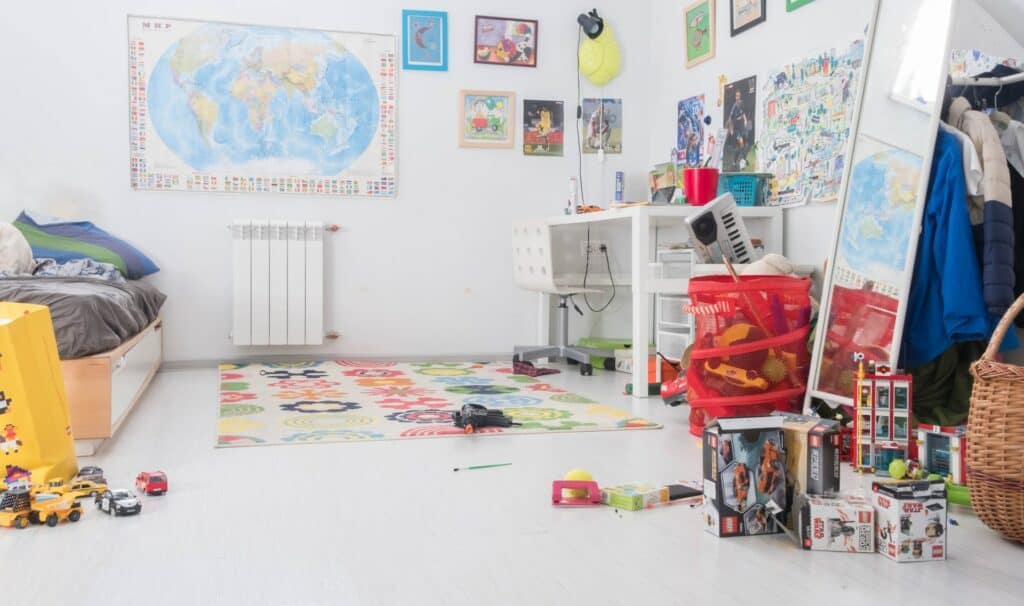
- Blue and green: These calming colors work well together and can create a relaxing environment for kids to play and unwind in.
- Pink and purple: These feminine colors are perfect for a girl’s living room and can be paired with white or gray to balance out the sweetness.
- Red and yellow: These energetic colors are perfect for a playroom and can create a lively and fun atmosphere.
Selecting Bedding
Bedding is an important part of any kid’s living room, as it provides a comfortable place for kids to rest and play. When selecting bedding, it’s important to consider the following factors:
- Comfort: Choose bedding that is soft and comfortable to the touch, as kids will spend a lot of time on it.
- Durability: Look for bedding that is made from high-quality materials and can withstand frequent washing and use.
- Design: Choose bedding that matches the color scheme and overall style of the living room. Consider adding fun patterns or prints to add some personality to the space.
Overall, when selecting a color scheme and bedding for a kid’s living room, it’s important to keep in mind the child’s preferences and needs, while also creating a balanced and comfortable space.
Creating a Focal Point
Designing a living room that appeals to kids can be challenging. However, creating a focal point can help to make the space more engaging and exciting for children. A focal point is a central design element that draws attention and creates a visual anchor in the room.
One way to create a focal point is by incorporating a bold and colorful statement piece. This could be a colorful rug, a piece of artwork, or a unique piece of furniture. By choosing a bold and eye-catching item, the space becomes more playful and fun for kids.
Another way to create a focal point is by using a themed decor. For example, a space-themed living room could feature a starry ceiling, a rocket-shaped bookshelf, and a moon-shaped rug. This creates a cohesive and immersive environment that encourages imaginative play.
In addition to visual elements, a focal point can also be created through functional design. For example, a reading nook with a cozy chair and bookshelves can be a great focal point for a living room. This encourages kids to read and learn while also creating a designated space for relaxation and quiet time.
Overall, creating a focal point in a living room for kids can be a fun and creative process. By incorporating bold design elements and functional spaces, the room becomes more engaging and exciting for children.
Designing a Playroom within the Living Room
When designing a living room for kids, it’s important to create a space that is both functional and fun. One way to do this is by incorporating a playroom within the living room. This allows kids to have a designated area to play while still being close to the rest of the family.
Incorporating a Den
One way to create a playroom within the living room is by incorporating a den. A den is a small, cozy space that can be used for reading, playing games, or just hanging out. To create a den, consider adding a teepee or a small tent to the room. This provides a designated area for play and can also serve as a quiet space for reading or relaxing.
Playroom Essentials
When designing a playroom within the living room, there are a few essential items to consider. These include:
- Storage: Kids tend to accumulate a lot of toys, so it’s important to have plenty of storage options. Consider adding baskets, bins, or shelves to the room to keep toys organized.
- Seating: Kids need a comfortable place to sit and play. Consider adding a bean bag chair or a small couch to the room.
- Art supplies: Encourage creativity by including art supplies in the playroom. Consider adding a small table and chairs for coloring and drawing.
By incorporating a den and including playroom essentials, you can create a functional and fun space for kids within the living room.
Innovative Wall Ideas
When designing a living room for kids, it’s important to consider innovative wall ideas that will make the space fun and engaging. Here are some creative ways to decorate your walls that your kids will love.
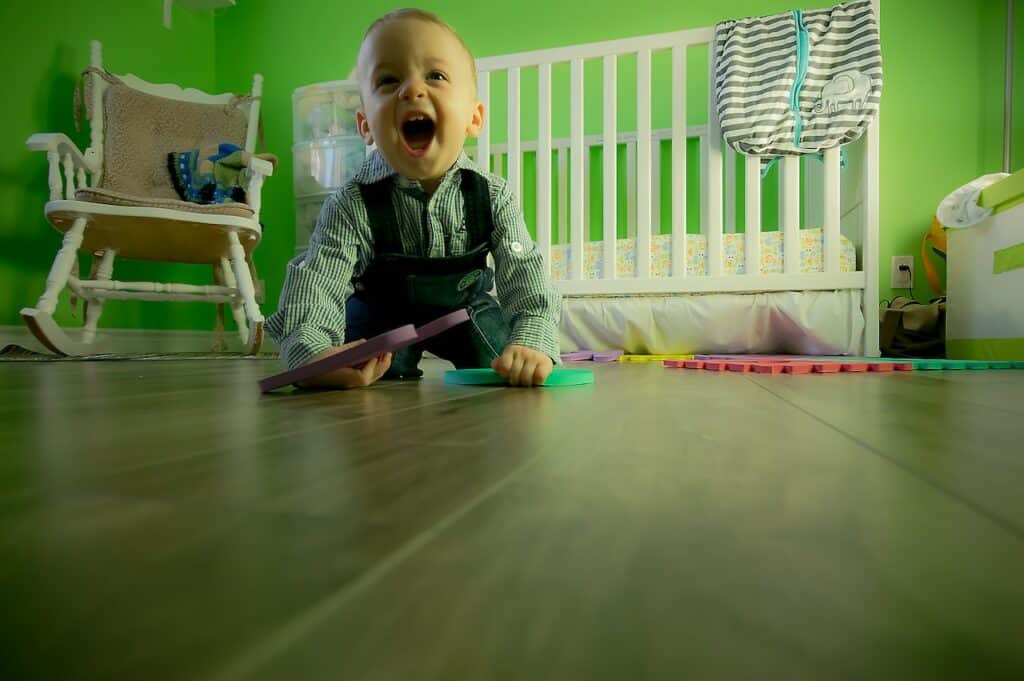
Using Chalkboard Paint
Chalkboard paint is a great way to turn your walls into a canvas for your kids to express their creativity. It’s easy to apply and can be used to create a variety of designs. You can paint an entire wall or just a section of it. Here are some ideas for using chalkboard paint in your living room:
- Create a chalkboard wall where your kids can draw and write messages.
- Use chalkboard paint to create a calendar, to-do list, or menu board.
- Paint a section of the wall with chalkboard paint and use it to display your kids’ artwork.
Wall Murals and Wallpaper
Wall murals and wallpaper are another great way to add personality and charm to your living room. Here are some ideas for using wall murals and wallpaper:
- Choose a whimsical wallpaper with a fun pattern or design.
- Create a custom wall mural featuring your kids’ favorite characters or themes.
- Use wallpaper to create an accent wall that adds color and texture to the space.
No matter which option you choose, be sure to involve your kids in the design process. This will ensure that they feel like the space is truly theirs and will help them develop a sense of ownership and pride in their living room.
Shelving and Storage Ottoman Ideas
When it comes to designing a living room for kids, one of the most important things to consider is storage. Clutter can make a room feel chaotic and overwhelming, which is not ideal for a space where children will be spending a lot of time. Shelving and storage ottomans are two great options for keeping toys, books, and other items organized and out of sight.
Shelving is a versatile storage solution that can be used to display decorative items or hold books, toys, and games. For a kid-friendly living room, consider installing floating shelves at a lower height so that children can easily access their favorite items. Another option is to use a bookshelf with adjustable shelves to accommodate items of different sizes.
Storage ottomans are another great option for a kid-friendly living room. These versatile pieces of furniture can be used as extra seating, a place to prop up feet, and a spot to store toys and games. Look for storage ottomans with a removable lid or built-in storage compartments to make it easy for kids to access their favorite items.
When choosing shelving and storage ottomans for a kid-friendly living room, it’s important to consider safety. Look for shelving with rounded corners and edges to prevent injuries, and choose storage ottomans with soft-close hinges to avoid little fingers getting caught. Additionally, make sure that any heavy items are stored on lower shelves or in the bottom of storage ottomans to prevent tipping.
Overall, shelving and storage ottomans are two great options for keeping a kid-friendly living room organized and clutter-free. By choosing safe, versatile storage solutions, parents can create a space that is both functional and fun for kids to play in.
Creating a Pet-Friendly Space
Pets are an important part of many families, and creating a pet-friendly living room is essential for both pets and their owners. Here are a few tips for creating a space that is comfortable and safe for pets.
1. Flooring
When it comes to flooring, it’s important to choose something that is durable and easy to clean. Hardwood floors, tile, and laminate flooring are all good options. Avoid carpeting, which can trap pet hair and odors.
2. Furniture
When choosing furniture for a pet-friendly living room, it’s important to consider the needs of both pets and humans. Choose furniture that is comfortable and easy to clean, such as leather or microfiber. Avoid fabrics that are easily stained or damaged.
3. Pet Beds
Providing a comfortable and cozy spot for pets to rest is important. Consider investing in a pet bed that is easy to clean and matches the decor of the room. Place the bed in a spot that is away from high traffic areas to give pets a sense of security.
4. Toys and Accessories
Toys and accessories are a great way to keep pets entertained and engaged. Choose toys that are safe and durable, and consider adding a scratching post for cats. Keep toys and accessories in a designated area to avoid cluttering the room.
5. Safety
Pet safety should always be a top priority. Make sure all electrical cords are out of reach, and avoid using toxic cleaning products. Keep plants and other potentially harmful items out of reach of pets.
By following these tips, it’s easy to create a pet-friendly living room that both pets and their owners will love.
Understanding Proportions and Primary Colors
When designing a living room for kids, it is important to consider the proportions of the furniture and decor. Children are smaller than adults, and their furniture should reflect that. Chairs, sofas, and tables should be appropriately sized for their age group to ensure comfort and safety.
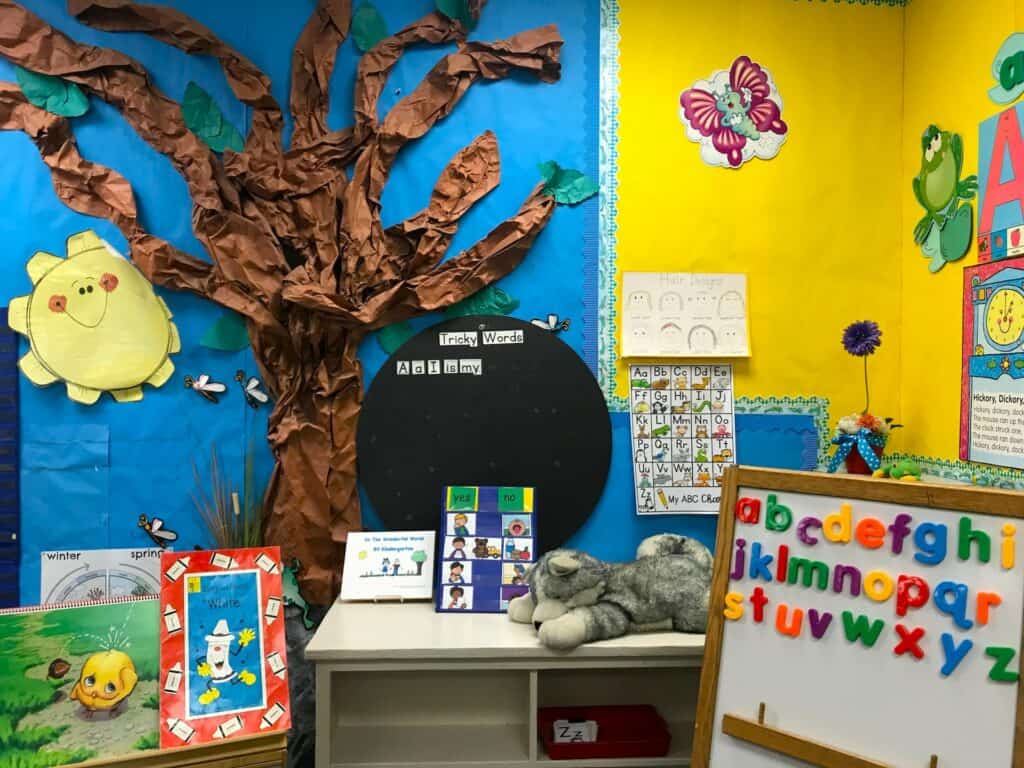
Primary colors are a great choice for a kid-friendly living room. These bold, bright colors are stimulating and engaging for children, and can help create a fun, playful atmosphere. Red, blue, and yellow are the three primary colors, and can be used in various combinations to create a vibrant and exciting space.
When using primary colors, it is important to balance them with neutral tones to avoid overwhelming the room. White, beige, and gray are good choices for walls and flooring, and can help create a cohesive look.
In addition to primary colors, it can be fun to incorporate secondary colors like orange, green, and purple. These colors can be used in accent pieces like throw pillows, rugs, or artwork to add visual interest without overpowering the space.
Overall, understanding proportions and primary colors is key to creating a living room that is both functional and fun for kids. By using appropriately sized furniture and incorporating bold, bright colors, you can create a space that is both safe and stimulating for children.
Using a Cart for Mobile Storage
A cart can be a great addition to a kid’s living room space. It can provide easy and mobile storage for toys, books, and other items. Here are a few things to consider when using a cart for mobile storage:
- Size: Make sure the cart is the right size for the space and the items you want to store. A smaller cart may be more appropriate for a smaller living room, while a larger cart may be better for a bigger space or more items.
- Material: Consider the material of the cart. A plastic cart may be easier to clean and more durable, while a wooden cart may provide a more natural and stylish look.
- Accessibility: Ensure that the items in the cart are easily accessible to the kids. Consider using baskets or bins to keep things organized and easily visible.
- Mobility: A cart with wheels can be easily moved around the living room, making it easier to clean or rearrange the space. However, be sure to choose a cart with sturdy and reliable wheels.
- Safety: Make sure the cart is safe for kids to use. Avoid sharp edges or corners, and ensure that the cart is stable and won’t tip over easily.
Using a cart for mobile storage can be a great way to keep a kid’s living room space organized and functional. With a little consideration for size, material, accessibility, mobility, and safety, a cart can be a valuable addition to any living room.
Also, check out an interesting article for your kids on 4 Things You Need To Check Before Getting A Scooter For Your Kid
Frequently Asked Questions
How can I create a safe and fun play area for kids in my living room?
To create a safe and fun play area for kids in your living room, consider using soft mats or rugs to cushion the floor. You can also use low furniture, such as bean bags or floor cushions, to create a comfortable and inviting space for kids to play. Additionally, it’s important to remove any hazardous items or breakable objects from the play area to prevent accidents.
What are some creative storage solutions for toys in a living room?
To keep toys organized in a living room, consider using storage baskets, bins, or shelves. You can also use furniture with built-in storage, such as ottomans or coffee tables with drawers. Another creative solution is to use a hanging organizer on the back of a door or wall to store smaller toys.
What type of furniture is best for a kid-friendly living room?
Kid-friendly furniture should be sturdy and easy to clean. Consider using furniture made of durable materials, such as leather or microfiber, that can withstand spills and stains. Additionally, furniture with rounded edges and no sharp corners can help prevent injuries.
How can I incorporate educational elements into my living room design for kids?
To incorporate educational elements into your living room design for kids, consider using wall decals or posters with educational themes, such as the alphabet or numbers. You can also use educational games or puzzles as decorative accents on shelves or tables. Additionally, consider incorporating a reading nook with a bookshelf and comfortable seating to encourage reading and learning.
What are some budget-friendly ways to decorate a living room for kids?
To decorate a living room for kids on a budget, consider using colorful throw pillows or blankets to add pops of color and texture. You can also use inexpensive wall art or posters to decorate the walls. Additionally, consider repurposing items you already have, such as using a toy chest as a coffee table.
What are some easy ways to make a living room more inviting for kids?
To make a living room more inviting for kids, consider using soft lighting, such as lamps or string lights, to create a cozy atmosphere. You can also use comfortable seating, such as bean bags or floor cushions, to create a relaxed and inviting space. Additionally, consider using fun and colorful accents, such as throw pillows or curtains, to add personality and style to the room.

Iesha is a loving mother of 2 beautiful children. She’s an active parent who enjoys indoor and outdoor adventures with her family. Her mission is to share practical and realistic parenting advice to help the parenting community becoming stronger.
